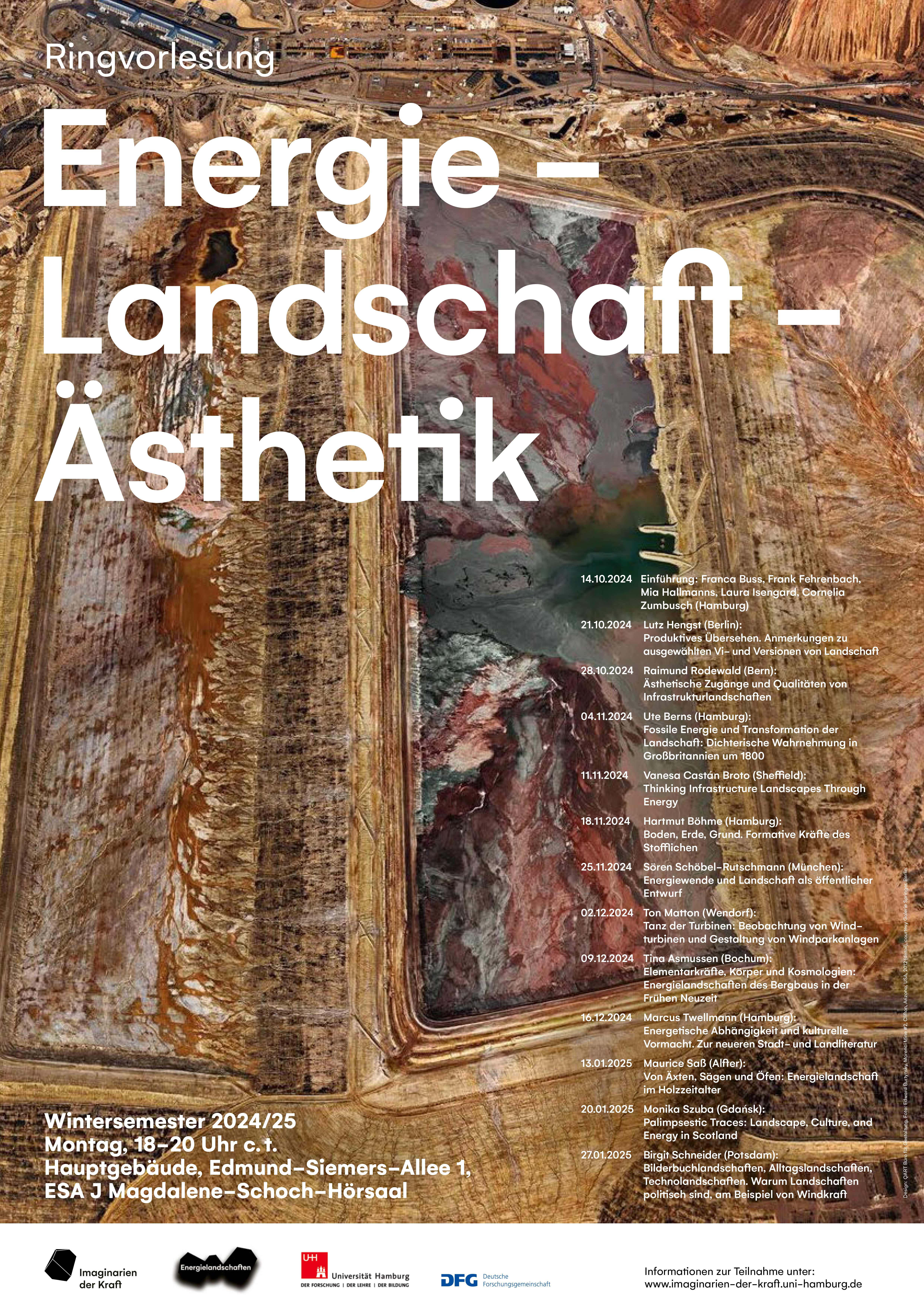RINGVORLESUNG

Description
The production and utilization of energy shapes the landscape. This has not only been true since the so-called ‚energy transition‘ and the focus on renewable energies, which ranges from the cultivation of energy plants such as rapeseed or maize to the construction of large-scale wind and solar parks and has decisively helped the concept of the energy landscape to gain popularity. Even before this development in Germany in the 19th century, the landscape was being used in various ways to extract energy resources: deforestation, dam construction and the mining and metallurgical industries already characterized a pre-industrial landscape. However, the landscape was also massively transformed by the extraction of fossil fuels, with open-cast mining also destroying the habitats of many animal and plant species, which now, with the switch to renewable energy sources, are faced with the question of their reutilization.
While the term "energy landscape" appears reasonable against the background of a geographical concept of landscape - landscape is defined here as the "physiognomic expression of the forces at work in a particular space" (L. E. Jedicke) - from the perspective of aesthetic landscape theory it seems to signify a contradiction, since landscape is generally defined as a place where nature can appear aesthetic to people precisely apart from its usability (J. Ritter). The currently emerging type of landscape thus requires new aesthetic categories and new ways of looking at nature.
A new relationship between energy, landscape and aesthetics is the subject of this lecture series. In line with ecocritically inspired cultural and literary studies, the aim is not to assume a necessary dichotomy between technology and nature, but rather to look at ways of thinking about the utilization and aesthetic design of natural space together. The focus is on the historical and cultural evolution of "energy landscape" as well as contemporary perspectives from different disciplinary angles. Here, the aim is to encourage a critical examination of the multi-layered concept of the energy landscape, which combines technical-economic, social, cultural and aesthetic-artistic levels.
Programme
Programme (updated 11.10.2024)
Venue: Main building, Edmund-Siemers-Allee 1, ESA J Magdalene-Schoch-Hörsaal
| 14.10.2024 |
Introduction: Franca Buss, Frank Fehrenbach, Mia Hallmanns, Laura Isengard, Cornelia Zumbusch (Hamburg) Unfortunately, the introduction has to be cancelled at short notice. |
| 21.10.2024 | Lutz Hengst (Berlin): Produktives Übersehen. Anmerkungen zu ausgewählten Vi- und Versionen von Landschaft |
| 28.10.2024 | Raimund Rodewald (Bern): Ästhetische Zugänge und Qualitäten von Infrastrukturlandschaften |
| 04.11.2024 | Ute Berns (Hamburg): Fossile Energie und Transformation der Landschaft: Dichterische Wahrnehmung in Großbritannien um 1800 |
| 11.11.2024 | Vanesa Castán Broto (Sheffield): Thinking Infrastructure Landscapes Through Energy |
| 18.11.2024 | Hartmut Böhme (Hamburg): Boden, Erde, Grund. Formative Kräfte des Stofflichen |
| 25.11.2024 | Sören Schöbel-Rutschmann (München): Energiewende und Landschaft als öffentlicher Entwurf |
| 02.12.2024 |
Ton Matton (Wendorf): Tanz der Turbinen: Beobachtung von Windturbinen und Gestaltung von Windparkanlagen This lecture is sponsored by the Co-Creation & Engagement Center of the Knowledge Exchange Agency (University of Hamburg). |
| 09.12.2024 | Tina Asmussen (Bochum): Elementarkräfte, Körper und Kosmologien: Energielandschaften des Bergbaus in der Frühen Neuzeit |
| 16.12.2024 | Marcus Twellmann (Hamburg): Energetische Abhängigkeit und kulturelle Vormacht. Zur neueren Stadt- und Landliteratur |
| 13.01.2025 | Maurice Saß (Alfter): Von Äxten, Sägen und Öfen: Energielandschaft im Holzzeitalter |
| 20.01.2025 | Monika Szuba (Gdańsk): Palimpsestic Traces: Landscape, Culture, and Energy in Scotland |
| 27.01.2025 | Birgit Schneider (Potsdam): Bilderbuchlandschaften, Alltagslandschaften, Technolandschaften. Warum Landschaften politisch sind, am Beispiel von Windkraft |
